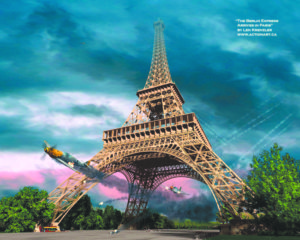

On the day the Japanese attacked Pearl Harbor, Bill Overstreet was working as a statistical engineer for Columbia Engineering and attending Morris Harvey College (now the University of Charleston) in Charleston, WV. Wanting to get in the Air Corps as a fighter pilot, Bill enlisted and did a lot of fast talking to get accepted into the program, and by February 1942 he was a private, waiting for an opening as an Aviation Cadet. After several months, he was sent to Santa Ana, California, for preflight training, and after several months at preflight, he was sent to Rankin Aeronautical Academy in Tulare, California.
The Rankin school’s founder and chief instructor, Tex Rankin, was a champion aerobatic pilot and often took the opportunity to demonstrate his skills. In keeping with Rankin’s vision, the school employed some unusual methods to produce skilled aviators, including surprising students mid-flight. One story Bill related was how his instructor, Carl Aarslef, while on the downwind leg of a landing pattern, at 500 feet, would suddenly turn the Stearman upside down, cut the engine, and say, “OK, you land it.” Of course, for Bill it was easy, as he put it: “just quarter roll it into a left turn, line up with the runway and set it down.” Bill theorized that the real test was for his reaction to the unexpected, and learning to keep one’s head in an unanticipated situation, where one second can mean the difference between life and death, was a useful skill for a pilot, and was certainly put to use over the course of Bill’s flying career.
In the spring of 1944 Bill and his P-51C, which he nicknamed the ‘Berlin Express,’ were near Paris when the scene that is immortalized in the artwork by Len Krenzler of Action Art occurred. Bill had followed a German BF109. The two planes had been in a running dogfight. The German pilot flew over Paris hoping that the heavy German anti-aircraft artillery would solve his problem and eliminate Overstreet.
The German’s engine was hit, but Bill stayed on his tail braving the intense enemy flak. His desperation undoubtedly growing, the German pilot aimed his plane at the Eiffel Tower and in a surprising maneuver, flew beneath it. Undeterred, Bill followed right behind him, scoring several more hits in the process. The German plane crashed and Bill escaped the heavy flak around Paris by flying low and full throttle over the river until he had cleared the city’s heavy anti-aircraft batteries.
On March 6, 1944, just after their first Berlin raid, the 357th received their first Citation, which stated: “On 6 March, 1944, the newly operational 357th Fighter Group provided target and withdrawal support to heavy bombardment aircraft bombing Berlin, which was the deepest penetration of single-engine fighters to that date. The thirty-three P-51 aircraft went directly to Berlin and picked up the first formations of B-17s just before their arrival over the city.
“They found the bombers being viciously attacked by one of the largest concentrations of twin-engine and single-engine fighters in the history of aerial warfare. From 100 to 150 single-engine and twin-engine fighters, some firing rockets, were operating in the immediate target area in groups of thirty to forty, as well as singly.
“Each combat wing of bombers was being hit as it arrived over Berlin; and, although they were sometimes outnumbered as much as 6 to 1, flights and sections of the 357th Group went to aid each combat wing as it arrived over the target, providing support in the air for over 30 minutes. Upwards of thirty enemy aircraft at a time were attacked by these separate flights and sections, and driven away from above and below the bombers.
“Some of the P-51s left their formations to engage enemy fighters below the bomber level in order to prevent them from reforming for further attacks. Though fighting under the most difficult conditions and subjected to constant anti-aircraft and enemy aircraft fire, so skillfully and aggressively were their attacks on the enemy fighters carried out that not a single aircraft of the 357th Group was lost.
“In driving enemy fighters away from the bombers, twenty Nazi fighters were destroyed, one probably destroyed and seven others damaged. On withdrawal, one flight of five P-51s strafed a large enemy airfield in central Germany, damaging three twin-engine and single-engine aircraft on the ground and killing 15-20 armed personnel before regaining altitude and returning to the bombers.”
In 2009, Overstreet was presented France’s Legion of Honor. Whenever the press interviewed him, always humble, he’d simply say, “I didn’t do anything. We were a team.”
Bill Overstreet died on December 29, 2013, at the age of 92.
No Comments
Leave a comment Cancel